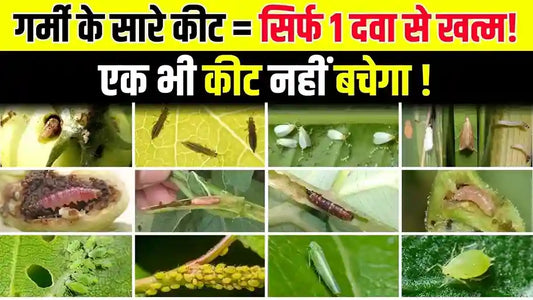The summertime has already begun. Are you anticipating the harvest of your beloved mangoes? Farmers beware! Fruit flies shouldn't interfere with your mango crop or reduce your revenues. It is essential that you safeguard the fruit from pests because it is the economically valuable component of this crop. Mango fruit flies, or Bactrocera dorsalis, are a major pest, especially when the fruit is developing and maturing.They may infest a sizable amount of the fruit, which will lower its quality and worth. A fruit fly infection can typically result in yield losses of between 25 and 30 percent. However, it can result in up to 90% loss in extreme circumstances. So, to ensure that your mango season is the most fruitful and profitable, take proactive measures through early detection, prevention, and management as advised in this article. 🥭🦟🚫🌞🍀
Symptoms of Fruit fly in Mango:
You should keep an eye out for the following indications to spot fruit fly infestation in mangoes:

- Fruit flies that are adult females pierce the skin of ripe fruits and lay their eggs in the inside flesh.
- When the eggs hatch, the maggots eat the fruit's pulp, causing it to rot and decompose.
- Fruit may become mushy, discolored, or acquire brown or black sunken spots or patches as the larvae feed on it.
- Mangoes that are harmed may display flaws and shriveling.
- Fruits with infestations may have gummy exudates or sticky secretions on their surface as a result of the larvae's internal eating.
- On the skin of the fruit, there are tiny larval exit holes.
- Fruits with infestations decay internally, resulting in a bad odor and fruit degeneration.
- Fruits with the problem may ripen too soon and fall off.
Preventive Measures:
Cultural:
- Avoid planting alternate host plants, such as melons, guava, papaya, and citrus, close to mango plantations.
- Remove any fallen or infested fruits from the orchard and collect and discard them there.
- Plow the orchard's topsoil down to a depth of about 10 cm between November and December to expose the pupae to sunlight and destroy them.
- Choose early-maturing cultivars so that the fruits can ripen when fruit flies are scarce.
- cultivate mango species with comparable growth periods.
- Maintain field sanitation and remove weeds from the area around the trees.
- To get rid of potential nesting places, cut down any old or wild trees in the orchard or close by.
Mechanical:
- To monitor and manage the fruit fly population, keep 6–8 Tapas fruit fly pheromone traps per acre.
- Install 4 to 6 yellow sticky traps for a 1-acre orchard to catch adult fruit flies, which are drawn to them because of their brilliant color.
- Bait traps: Fruit flies can be attracted to and captured using food baits, whether they are protein- or sugar-based. 🍽️🦟 Use traps with methyl eugenol, 4–6, to entice and kill male fruit flies. It can be made by putting 10 ml of the mixture (1 ml/lit methyl eugenol + 2 ml/lit lambda-cyhalothrin) in a cotton ball and placing it in each trap. To catch fruit flies, you can also use other food baits like yeast, sugar syrup, or ripe or overripe mangoes or bananas that have been poisoned. 🪰🍯🍌
(NOTE: Effective trapping depends on the timing and location of the traps. Place the traps from the time the fruit is developing until it is harvested. Additionally, hang or place the traps close to regions with a lot of fruit fly activity)
Physical Barrier:
- Mango fruits should be sealed in bags with fine mesh nets or covers to act as a physical barrier and keep fruit flies away. 🛍️🥭🪰
Biological:
- Neem oil should be sprayed in intervals of 2 to 3 ml per liter of water. 🌿🌱💧
- Additionally, you can introduce organic predators like parasitic wasps. 🐝🌼
ITK Practices to control Fruit flies in Mango:
- 20 grams of Ocimum sanctum (holy basil) leaves should be crushed. 🌿
- Put the extract and the crushed leaves inside a coconut shell. 🥥
- Then, pour 100 cc of water into the coconut shell. 💧
- Add 0.5 grams of citric acid to the extract to prolong its life. 🍋
- Add 0.5 grams of carbofuran 3G to the extract to make it poisonous. ☠️
- Four traps should be hung from the branches of each mango tree. 🌳🪤
- Create two holes on the 2-liter disposable water bottle, 5 cm above the bottom, to use as a trap. 🍾
- Put a string through the hole to hang it. 🧵
- Make a fruit fly attractant by mixing one cup each of vinegar, water, and honey with two cups of each. 🥄🍯
- Shake the combination, then pour it into the trap until it reaches the level of the holes. 🕳️
- Suspend the trap at a height of around 5 feet. 🪝🔝
Control Measures:
Preventive approaches must be prioritized before turning to chemical management for fruit fly control to be effective. 🚫🪰
In the case that preventive measures alone are unable to eliminate the infestation, consider chemical control as a last alternative. ⚠️🌿🪲
Bait Splash:
You can spray bait on the tree trunk once a week if there is a serious infestation, which is defined as finding more than 5 flies per trap per day. To make it, combine 1 liter of water with 100 grams of molasses or jaggery and 2 ml/lit of deltamethrin. 🌳🪰🌊
Biological Insecticide:
Chemical Management:
|
Product name |
Technical content |
Dosage |
|
Deltamethrin 2.8 EC |
1.5 - 2 ml/L |
|
|
Fipronil 40% + Imidacloprid 40% WDG |
6-7 Gram in 15 Liter Water |
(NOTE: Along with neem oil, the aforementioned insecticides can be sprayed. For information about the ideal application window, consult the product's description. 🌿🪴🌼)
Post-harvest Treatment:
Treat the harvested fruits with hot water at 48˚C for 1 hour.
Conclusion:
Follow the above-mentioned preventive methods, such as using traps, installing excellent cultural practices, and routinely spraying neem oil, together with chemical management to get rid of the pest attack, to protect your mangoes from fruit fly attack. By doing this, you may protect the fruits' quality while ensuring a higher output and profit. 🥭🪰🌳










